EBUS 536 Essay: Exploring Leaders Role in Team Development
VerifiedAdded on 2023/06/18
|10
|3666
|219
Essay
AI Summary
This essay examines the pivotal role leaders play in the development of their team members, addressing whether staff development is primarily the leader's responsibility or that of the individual employee. It delves into leadership theories, such as Douglas McGregor's Theory X and Theory Y, and explores various leadership styles, including authoritarian, democratic, and laissez-faire, illustrating their impact on team dynamics and employee motivation. The essay emphasizes the importance of leaders in providing vision, motivation, and guidance, while also considering the individual employee's accountability in their own professional growth. Real-life examples and academic citations are used to support the analysis, highlighting the multifaceted nature of leadership in fostering effective team and staff development. Desklib provides access to similar essays and study resources for students.

EBUS 536
Paraphrase This Document
Need a fresh take? Get an instant paraphrase of this document with our AI Paraphraser
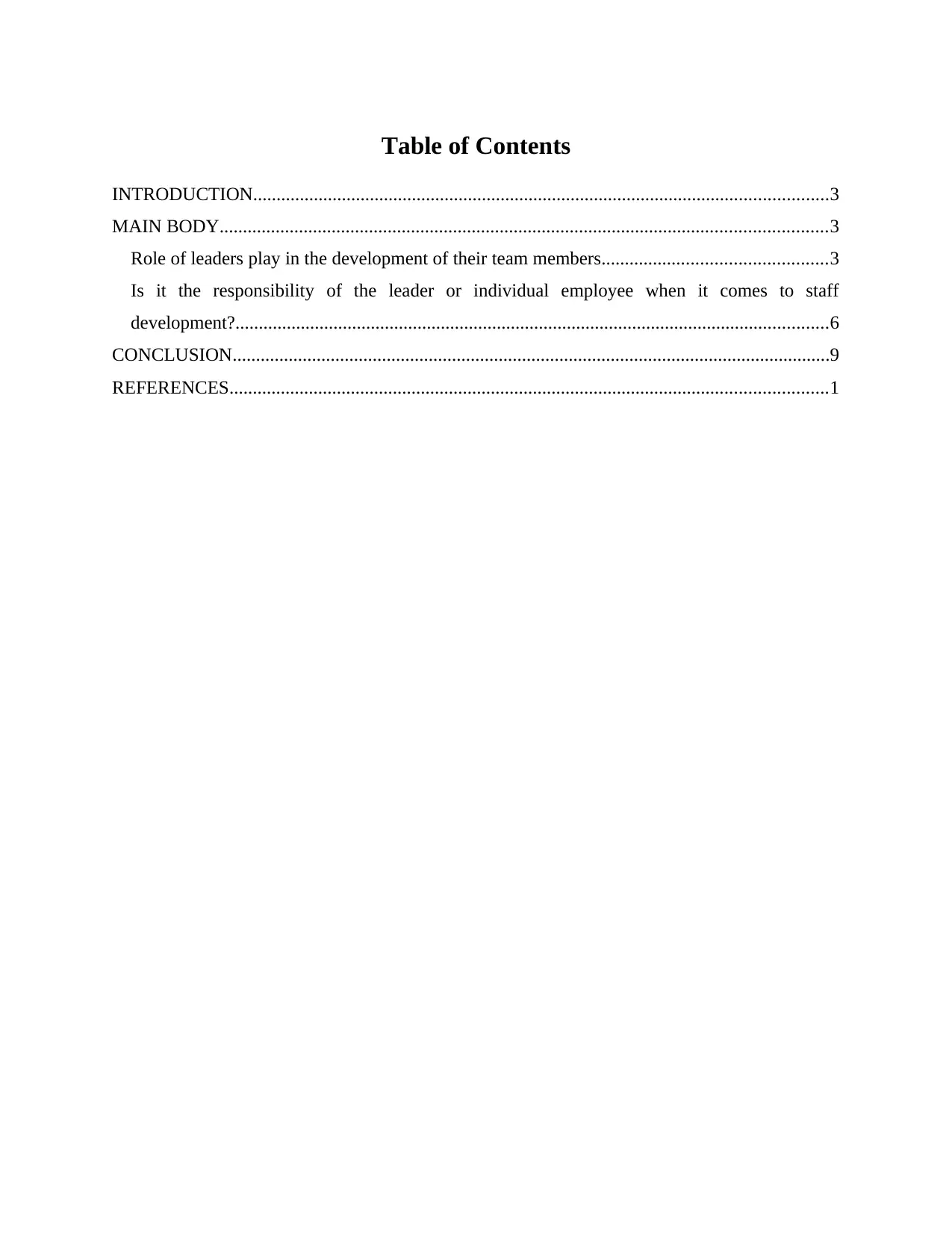
Table of Contents
INTRODUCTION...........................................................................................................................3
MAIN BODY..................................................................................................................................3
Role of leaders play in the development of their team members................................................3
Is it the responsibility of the leader or individual employee when it comes to staff
development?...............................................................................................................................6
CONCLUSION................................................................................................................................9
REFERENCES................................................................................................................................1
INTRODUCTION...........................................................................................................................3
MAIN BODY..................................................................................................................................3
Role of leaders play in the development of their team members................................................3
Is it the responsibility of the leader or individual employee when it comes to staff
development?...............................................................................................................................6
CONCLUSION................................................................................................................................9
REFERENCES................................................................................................................................1
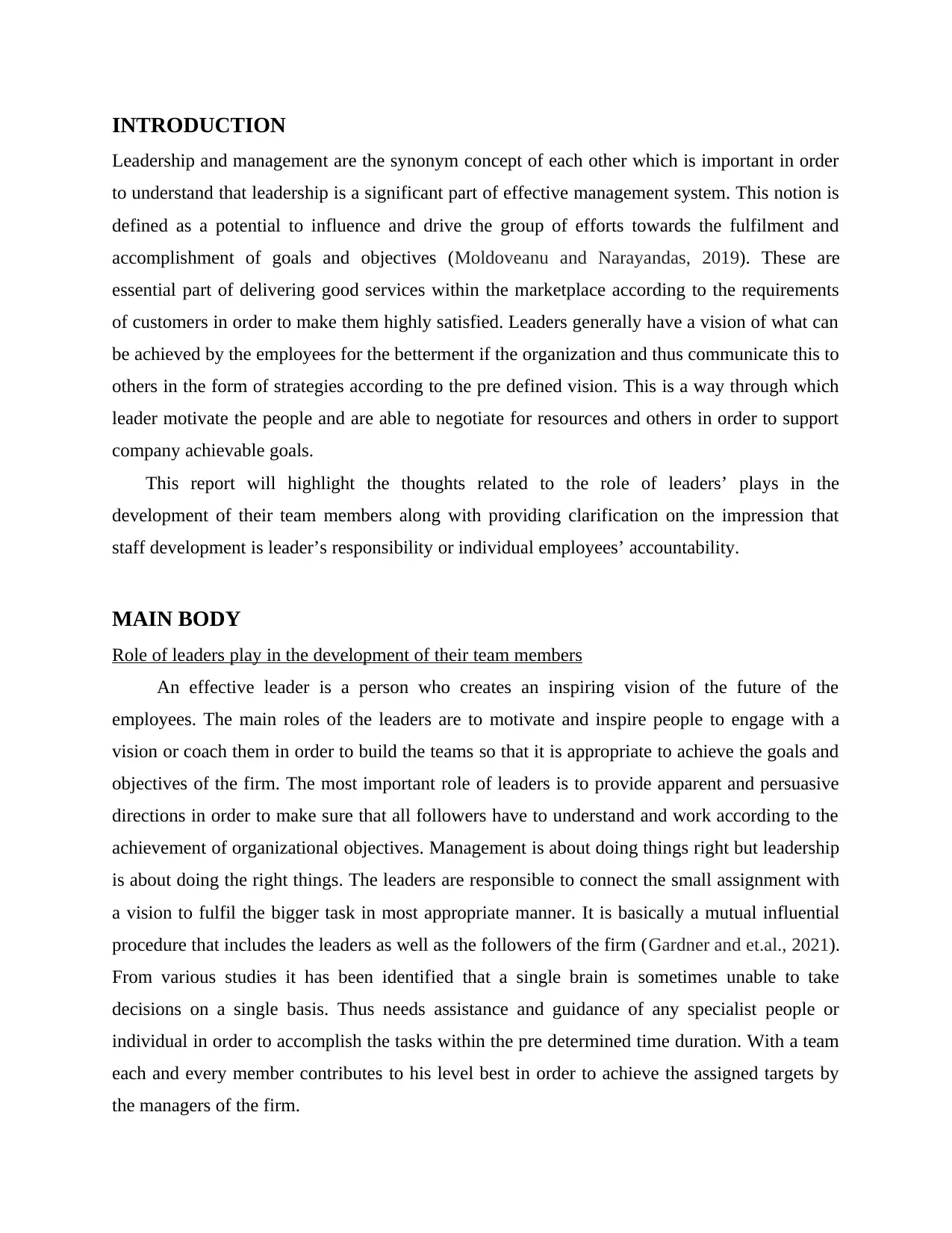
INTRODUCTION
Leadership and management are the synonym concept of each other which is important in order
to understand that leadership is a significant part of effective management system. This notion is
defined as a potential to influence and drive the group of efforts towards the fulfilment and
accomplishment of goals and objectives (Moldoveanu and Narayandas, 2019). These are
essential part of delivering good services within the marketplace according to the requirements
of customers in order to make them highly satisfied. Leaders generally have a vision of what can
be achieved by the employees for the betterment if the organization and thus communicate this to
others in the form of strategies according to the pre defined vision. This is a way through which
leader motivate the people and are able to negotiate for resources and others in order to support
company achievable goals.
This report will highlight the thoughts related to the role of leaders’ plays in the
development of their team members along with providing clarification on the impression that
staff development is leader’s responsibility or individual employees’ accountability.
MAIN BODY
Role of leaders play in the development of their team members
An effective leader is a person who creates an inspiring vision of the future of the
employees. The main roles of the leaders are to motivate and inspire people to engage with a
vision or coach them in order to build the teams so that it is appropriate to achieve the goals and
objectives of the firm. The most important role of leaders is to provide apparent and persuasive
directions in order to make sure that all followers have to understand and work according to the
achievement of organizational objectives. Management is about doing things right but leadership
is about doing the right things. The leaders are responsible to connect the small assignment with
a vision to fulfil the bigger task in most appropriate manner. It is basically a mutual influential
procedure that includes the leaders as well as the followers of the firm (Gardner and et.al., 2021).
From various studies it has been identified that a single brain is sometimes unable to take
decisions on a single basis. Thus needs assistance and guidance of any specialist people or
individual in order to accomplish the tasks within the pre determined time duration. With a team
each and every member contributes to his level best in order to achieve the assigned targets by
the managers of the firm.
Leadership and management are the synonym concept of each other which is important in order
to understand that leadership is a significant part of effective management system. This notion is
defined as a potential to influence and drive the group of efforts towards the fulfilment and
accomplishment of goals and objectives (Moldoveanu and Narayandas, 2019). These are
essential part of delivering good services within the marketplace according to the requirements
of customers in order to make them highly satisfied. Leaders generally have a vision of what can
be achieved by the employees for the betterment if the organization and thus communicate this to
others in the form of strategies according to the pre defined vision. This is a way through which
leader motivate the people and are able to negotiate for resources and others in order to support
company achievable goals.
This report will highlight the thoughts related to the role of leaders’ plays in the
development of their team members along with providing clarification on the impression that
staff development is leader’s responsibility or individual employees’ accountability.
MAIN BODY
Role of leaders play in the development of their team members
An effective leader is a person who creates an inspiring vision of the future of the
employees. The main roles of the leaders are to motivate and inspire people to engage with a
vision or coach them in order to build the teams so that it is appropriate to achieve the goals and
objectives of the firm. The most important role of leaders is to provide apparent and persuasive
directions in order to make sure that all followers have to understand and work according to the
achievement of organizational objectives. Management is about doing things right but leadership
is about doing the right things. The leaders are responsible to connect the small assignment with
a vision to fulfil the bigger task in most appropriate manner. It is basically a mutual influential
procedure that includes the leaders as well as the followers of the firm (Gardner and et.al., 2021).
From various studies it has been identified that a single brain is sometimes unable to take
decisions on a single basis. Thus needs assistance and guidance of any specialist people or
individual in order to accomplish the tasks within the pre determined time duration. With a team
each and every member contributes to his level best in order to achieve the assigned targets by
the managers of the firm.
⊘ This is a preview!⊘
Do you want full access?
Subscribe today to unlock all pages.

Trusted by 1+ million students worldwide
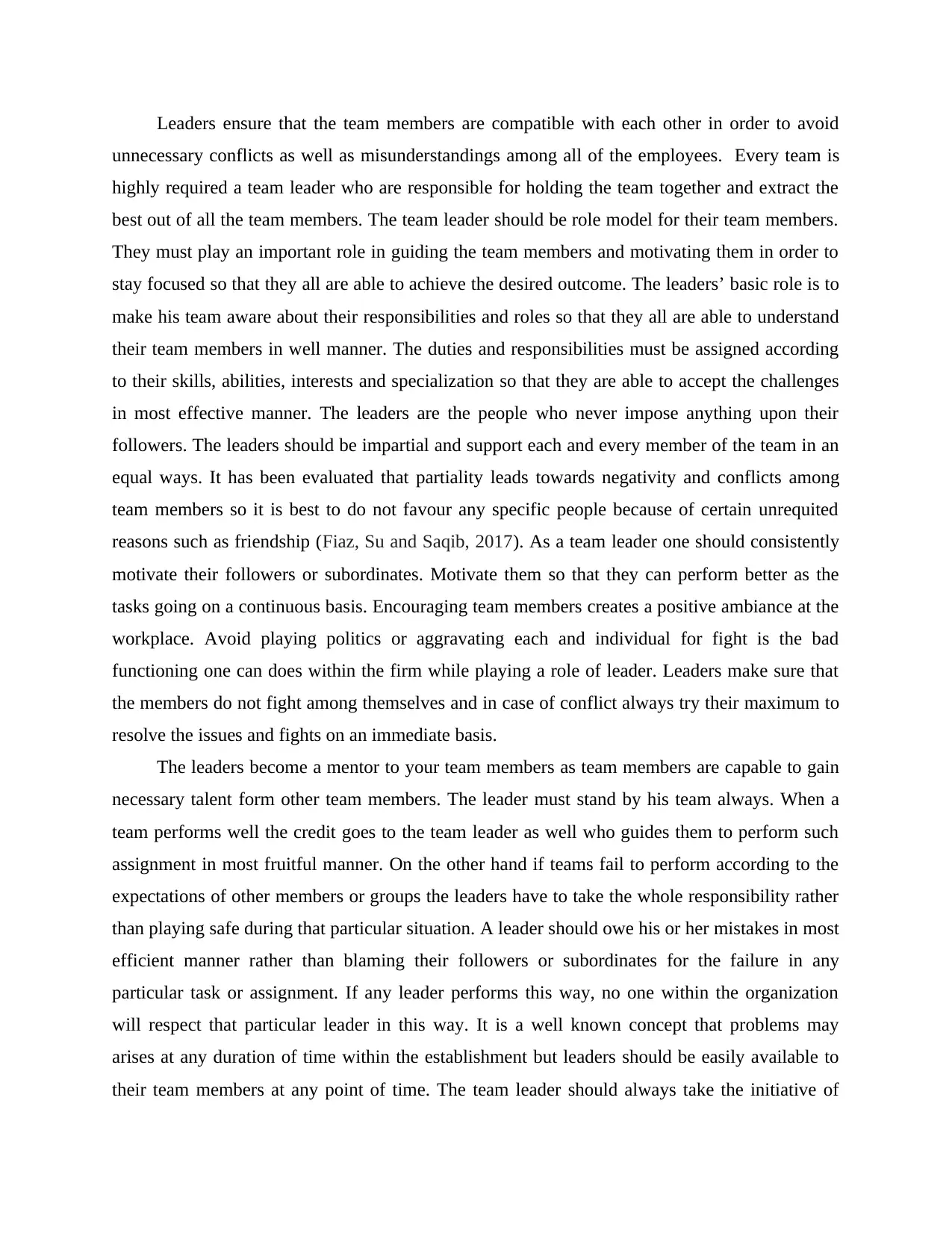
Leaders ensure that the team members are compatible with each other in order to avoid
unnecessary conflicts as well as misunderstandings among all of the employees. Every team is
highly required a team leader who are responsible for holding the team together and extract the
best out of all the team members. The team leader should be role model for their team members.
They must play an important role in guiding the team members and motivating them in order to
stay focused so that they all are able to achieve the desired outcome. The leaders’ basic role is to
make his team aware about their responsibilities and roles so that they all are able to understand
their team members in well manner. The duties and responsibilities must be assigned according
to their skills, abilities, interests and specialization so that they are able to accept the challenges
in most effective manner. The leaders are the people who never impose anything upon their
followers. The leaders should be impartial and support each and every member of the team in an
equal ways. It has been evaluated that partiality leads towards negativity and conflicts among
team members so it is best to do not favour any specific people because of certain unrequited
reasons such as friendship (Fiaz, Su and Saqib, 2017). As a team leader one should consistently
motivate their followers or subordinates. Motivate them so that they can perform better as the
tasks going on a continuous basis. Encouraging team members creates a positive ambiance at the
workplace. Avoid playing politics or aggravating each and individual for fight is the bad
functioning one can does within the firm while playing a role of leader. Leaders make sure that
the members do not fight among themselves and in case of conflict always try their maximum to
resolve the issues and fights on an immediate basis.
The leaders become a mentor to your team members as team members are capable to gain
necessary talent form other team members. The leader must stand by his team always. When a
team performs well the credit goes to the team leader as well who guides them to perform such
assignment in most fruitful manner. On the other hand if teams fail to perform according to the
expectations of other members or groups the leaders have to take the whole responsibility rather
than playing safe during that particular situation. A leader should owe his or her mistakes in most
efficient manner rather than blaming their followers or subordinates for the failure in any
particular task or assignment. If any leader performs this way, no one within the organization
will respect that particular leader in this way. It is a well known concept that problems may
arises at any duration of time within the establishment but leaders should be easily available to
their team members at any point of time. The team leader should always take the initiative of
unnecessary conflicts as well as misunderstandings among all of the employees. Every team is
highly required a team leader who are responsible for holding the team together and extract the
best out of all the team members. The team leader should be role model for their team members.
They must play an important role in guiding the team members and motivating them in order to
stay focused so that they all are able to achieve the desired outcome. The leaders’ basic role is to
make his team aware about their responsibilities and roles so that they all are able to understand
their team members in well manner. The duties and responsibilities must be assigned according
to their skills, abilities, interests and specialization so that they are able to accept the challenges
in most effective manner. The leaders are the people who never impose anything upon their
followers. The leaders should be impartial and support each and every member of the team in an
equal ways. It has been evaluated that partiality leads towards negativity and conflicts among
team members so it is best to do not favour any specific people because of certain unrequited
reasons such as friendship (Fiaz, Su and Saqib, 2017). As a team leader one should consistently
motivate their followers or subordinates. Motivate them so that they can perform better as the
tasks going on a continuous basis. Encouraging team members creates a positive ambiance at the
workplace. Avoid playing politics or aggravating each and individual for fight is the bad
functioning one can does within the firm while playing a role of leader. Leaders make sure that
the members do not fight among themselves and in case of conflict always try their maximum to
resolve the issues and fights on an immediate basis.
The leaders become a mentor to your team members as team members are capable to gain
necessary talent form other team members. The leader must stand by his team always. When a
team performs well the credit goes to the team leader as well who guides them to perform such
assignment in most fruitful manner. On the other hand if teams fail to perform according to the
expectations of other members or groups the leaders have to take the whole responsibility rather
than playing safe during that particular situation. A leader should owe his or her mistakes in most
efficient manner rather than blaming their followers or subordinates for the failure in any
particular task or assignment. If any leader performs this way, no one within the organization
will respect that particular leader in this way. It is a well known concept that problems may
arises at any duration of time within the establishment but leaders should be easily available to
their team members at any point of time. The team leader should always take the initiative of
Paraphrase This Document
Need a fresh take? Get an instant paraphrase of this document with our AI Paraphraser
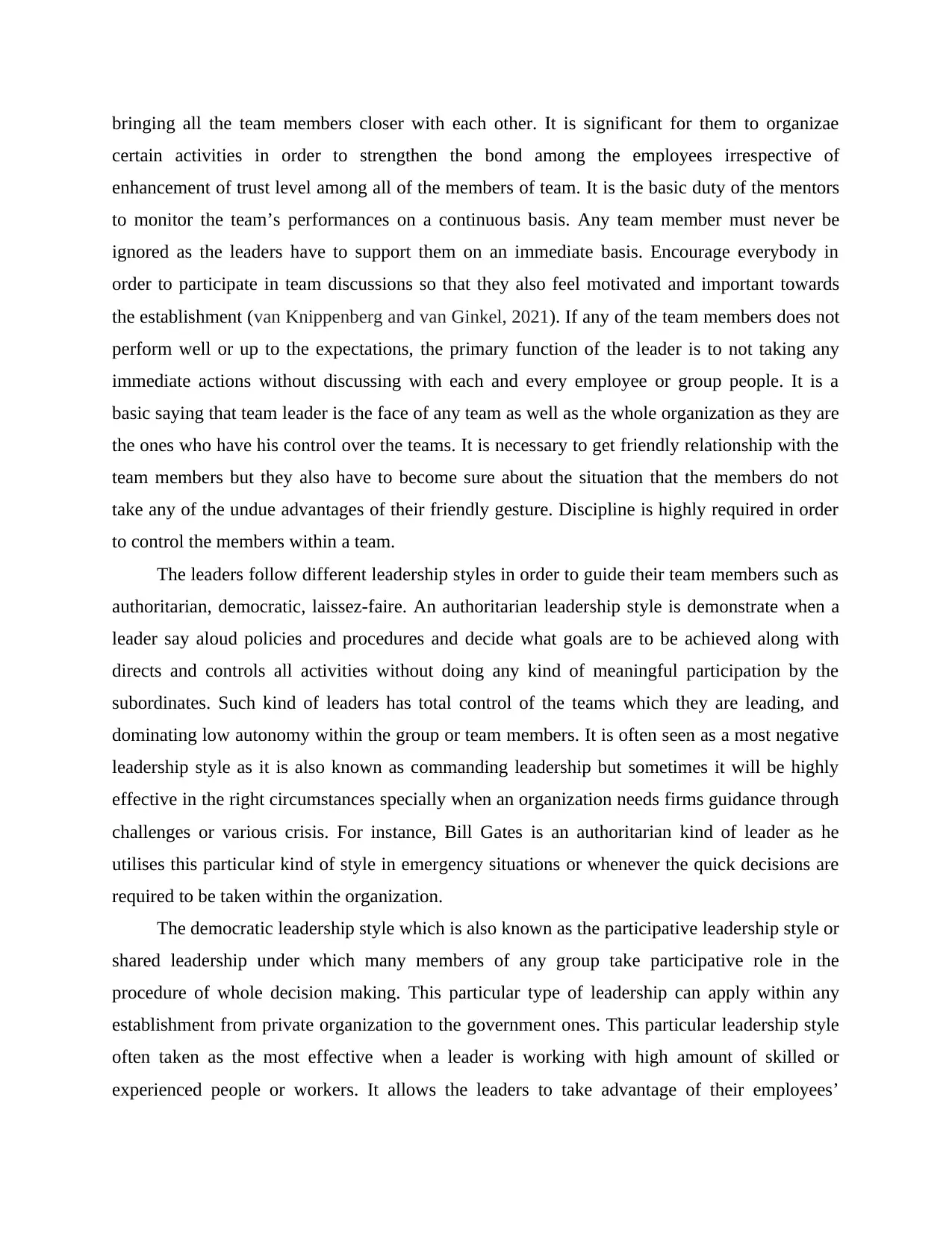
bringing all the team members closer with each other. It is significant for them to organizae
certain activities in order to strengthen the bond among the employees irrespective of
enhancement of trust level among all of the members of team. It is the basic duty of the mentors
to monitor the team’s performances on a continuous basis. Any team member must never be
ignored as the leaders have to support them on an immediate basis. Encourage everybody in
order to participate in team discussions so that they also feel motivated and important towards
the establishment (van Knippenberg and van Ginkel, 2021). If any of the team members does not
perform well or up to the expectations, the primary function of the leader is to not taking any
immediate actions without discussing with each and every employee or group people. It is a
basic saying that team leader is the face of any team as well as the whole organization as they are
the ones who have his control over the teams. It is necessary to get friendly relationship with the
team members but they also have to become sure about the situation that the members do not
take any of the undue advantages of their friendly gesture. Discipline is highly required in order
to control the members within a team.
The leaders follow different leadership styles in order to guide their team members such as
authoritarian, democratic, laissez-faire. An authoritarian leadership style is demonstrate when a
leader say aloud policies and procedures and decide what goals are to be achieved along with
directs and controls all activities without doing any kind of meaningful participation by the
subordinates. Such kind of leaders has total control of the teams which they are leading, and
dominating low autonomy within the group or team members. It is often seen as a most negative
leadership style as it is also known as commanding leadership but sometimes it will be highly
effective in the right circumstances specially when an organization needs firms guidance through
challenges or various crisis. For instance, Bill Gates is an authoritarian kind of leader as he
utilises this particular kind of style in emergency situations or whenever the quick decisions are
required to be taken within the organization.
The democratic leadership style which is also known as the participative leadership style or
shared leadership under which many members of any group take participative role in the
procedure of whole decision making. This particular type of leadership can apply within any
establishment from private organization to the government ones. This particular leadership style
often taken as the most effective when a leader is working with high amount of skilled or
experienced people or workers. It allows the leaders to take advantage of their employees’
certain activities in order to strengthen the bond among the employees irrespective of
enhancement of trust level among all of the members of team. It is the basic duty of the mentors
to monitor the team’s performances on a continuous basis. Any team member must never be
ignored as the leaders have to support them on an immediate basis. Encourage everybody in
order to participate in team discussions so that they also feel motivated and important towards
the establishment (van Knippenberg and van Ginkel, 2021). If any of the team members does not
perform well or up to the expectations, the primary function of the leader is to not taking any
immediate actions without discussing with each and every employee or group people. It is a
basic saying that team leader is the face of any team as well as the whole organization as they are
the ones who have his control over the teams. It is necessary to get friendly relationship with the
team members but they also have to become sure about the situation that the members do not
take any of the undue advantages of their friendly gesture. Discipline is highly required in order
to control the members within a team.
The leaders follow different leadership styles in order to guide their team members such as
authoritarian, democratic, laissez-faire. An authoritarian leadership style is demonstrate when a
leader say aloud policies and procedures and decide what goals are to be achieved along with
directs and controls all activities without doing any kind of meaningful participation by the
subordinates. Such kind of leaders has total control of the teams which they are leading, and
dominating low autonomy within the group or team members. It is often seen as a most negative
leadership style as it is also known as commanding leadership but sometimes it will be highly
effective in the right circumstances specially when an organization needs firms guidance through
challenges or various crisis. For instance, Bill Gates is an authoritarian kind of leader as he
utilises this particular kind of style in emergency situations or whenever the quick decisions are
required to be taken within the organization.
The democratic leadership style which is also known as the participative leadership style or
shared leadership under which many members of any group take participative role in the
procedure of whole decision making. This particular type of leadership can apply within any
establishment from private organization to the government ones. This particular leadership style
often taken as the most effective when a leader is working with high amount of skilled or
experienced people or workers. It allows the leaders to take advantage of their employees’
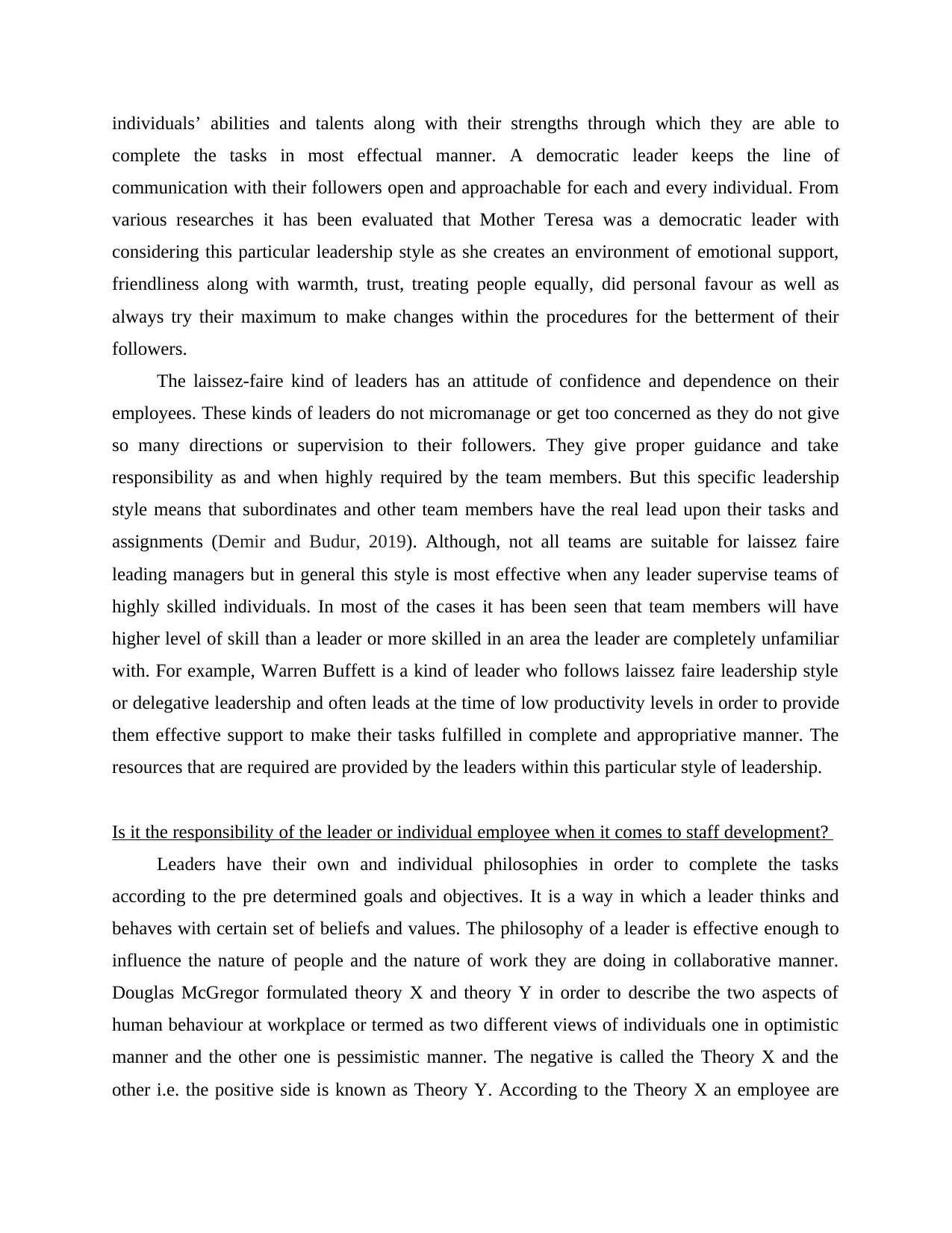
individuals’ abilities and talents along with their strengths through which they are able to
complete the tasks in most effectual manner. A democratic leader keeps the line of
communication with their followers open and approachable for each and every individual. From
various researches it has been evaluated that Mother Teresa was a democratic leader with
considering this particular leadership style as she creates an environment of emotional support,
friendliness along with warmth, trust, treating people equally, did personal favour as well as
always try their maximum to make changes within the procedures for the betterment of their
followers.
The laissez-faire kind of leaders has an attitude of confidence and dependence on their
employees. These kinds of leaders do not micromanage or get too concerned as they do not give
so many directions or supervision to their followers. They give proper guidance and take
responsibility as and when highly required by the team members. But this specific leadership
style means that subordinates and other team members have the real lead upon their tasks and
assignments (Demir and Budur, 2019). Although, not all teams are suitable for laissez faire
leading managers but in general this style is most effective when any leader supervise teams of
highly skilled individuals. In most of the cases it has been seen that team members will have
higher level of skill than a leader or more skilled in an area the leader are completely unfamiliar
with. For example, Warren Buffett is a kind of leader who follows laissez faire leadership style
or delegative leadership and often leads at the time of low productivity levels in order to provide
them effective support to make their tasks fulfilled in complete and appropriative manner. The
resources that are required are provided by the leaders within this particular style of leadership.
Is it the responsibility of the leader or individual employee when it comes to staff development?
Leaders have their own and individual philosophies in order to complete the tasks
according to the pre determined goals and objectives. It is a way in which a leader thinks and
behaves with certain set of beliefs and values. The philosophy of a leader is effective enough to
influence the nature of people and the nature of work they are doing in collaborative manner.
Douglas McGregor formulated theory X and theory Y in order to describe the two aspects of
human behaviour at workplace or termed as two different views of individuals one in optimistic
manner and the other one is pessimistic manner. The negative is called the Theory X and the
other i.e. the positive side is known as Theory Y. According to the Theory X an employee are
complete the tasks in most effectual manner. A democratic leader keeps the line of
communication with their followers open and approachable for each and every individual. From
various researches it has been evaluated that Mother Teresa was a democratic leader with
considering this particular leadership style as she creates an environment of emotional support,
friendliness along with warmth, trust, treating people equally, did personal favour as well as
always try their maximum to make changes within the procedures for the betterment of their
followers.
The laissez-faire kind of leaders has an attitude of confidence and dependence on their
employees. These kinds of leaders do not micromanage or get too concerned as they do not give
so many directions or supervision to their followers. They give proper guidance and take
responsibility as and when highly required by the team members. But this specific leadership
style means that subordinates and other team members have the real lead upon their tasks and
assignments (Demir and Budur, 2019). Although, not all teams are suitable for laissez faire
leading managers but in general this style is most effective when any leader supervise teams of
highly skilled individuals. In most of the cases it has been seen that team members will have
higher level of skill than a leader or more skilled in an area the leader are completely unfamiliar
with. For example, Warren Buffett is a kind of leader who follows laissez faire leadership style
or delegative leadership and often leads at the time of low productivity levels in order to provide
them effective support to make their tasks fulfilled in complete and appropriative manner. The
resources that are required are provided by the leaders within this particular style of leadership.
Is it the responsibility of the leader or individual employee when it comes to staff development?
Leaders have their own and individual philosophies in order to complete the tasks
according to the pre determined goals and objectives. It is a way in which a leader thinks and
behaves with certain set of beliefs and values. The philosophy of a leader is effective enough to
influence the nature of people and the nature of work they are doing in collaborative manner.
Douglas McGregor formulated theory X and theory Y in order to describe the two aspects of
human behaviour at workplace or termed as two different views of individuals one in optimistic
manner and the other one is pessimistic manner. The negative is called the Theory X and the
other i.e. the positive side is known as Theory Y. According to the Theory X an employee are
⊘ This is a preview!⊘
Do you want full access?
Subscribe today to unlock all pages.

Trusted by 1+ million students worldwide

not at all interested in doing their work and tries their maximum to escape whenever and
wherever possible. As the employees does not want to work within the firm or warned and
punished by the leaders so as to achieve organizational goals. According to this theory,
employees do not like responsibilities, does not resist change and needs formal directions. Apart
from this, Theory Y illustrates that employees can perceive their job as relaxing and normal in
nature (Torlak and Kuzey, 2019). If the job profile is efficient enough to provide rewards and
satisfy the needs of the employees, then it will automatically lead towards the loyalty and
commitment towards the firm. Thus, it has been identified that Theory X presents pessimistic
view of employees whereas the Theory Y presents positive side of the employees’ behaviour at
work space.
The basic and primary role of leaders is to provide clear and convincing instructions to make
sure about that all their followers are ready to understand and work according to the given
directions in order to achieve organizational objectives. Providing a clear vision for the entire
team is the foremost and single most important role a leader should play within an organization.
Employees are unable to participate in any common effort if they do not know about the goals of
the task (Ho and Fu, 2018). Thus leaders are the ones who provide guidance to the employees in
order to fulfil the requirements of the firm within the accomplishment of common goals. Hence it
is completely the responsibility of the leader when it comes to the development of the staff as
well as team members. As with the proper and efficient support from the leaders, the staff
members are feel valued and strengthened along with feeling appreciated and supported in all
means within the workplace. Effective leadership is highly beneficial for motivating the staff
members to reach their full and complete potential and provide the best learning experience for
the people working within the firm. The leadership style which includes mentoring is defined as
an individual who is experienced in a field creates a relationship with another less experienced
individual to expand their skills as well as knowledge. Mentoring is useful strategy as it allows
further support, guidance and information that are required by the staff members in order to
develop their understanding level towards the assignments given to them for the accomplishment
of goals and objectives. Authentic leadership works as guiding the procedure of positive change
by providing various opportunities for staff members’ participation and in order to build strong
relationships with each other (Cardiff, McCormack and McCance, 2018). This leadership
promotes truthful and open minded communication embraces the compilation of expansion and
wherever possible. As the employees does not want to work within the firm or warned and
punished by the leaders so as to achieve organizational goals. According to this theory,
employees do not like responsibilities, does not resist change and needs formal directions. Apart
from this, Theory Y illustrates that employees can perceive their job as relaxing and normal in
nature (Torlak and Kuzey, 2019). If the job profile is efficient enough to provide rewards and
satisfy the needs of the employees, then it will automatically lead towards the loyalty and
commitment towards the firm. Thus, it has been identified that Theory X presents pessimistic
view of employees whereas the Theory Y presents positive side of the employees’ behaviour at
work space.
The basic and primary role of leaders is to provide clear and convincing instructions to make
sure about that all their followers are ready to understand and work according to the given
directions in order to achieve organizational objectives. Providing a clear vision for the entire
team is the foremost and single most important role a leader should play within an organization.
Employees are unable to participate in any common effort if they do not know about the goals of
the task (Ho and Fu, 2018). Thus leaders are the ones who provide guidance to the employees in
order to fulfil the requirements of the firm within the accomplishment of common goals. Hence it
is completely the responsibility of the leader when it comes to the development of the staff as
well as team members. As with the proper and efficient support from the leaders, the staff
members are feel valued and strengthened along with feeling appreciated and supported in all
means within the workplace. Effective leadership is highly beneficial for motivating the staff
members to reach their full and complete potential and provide the best learning experience for
the people working within the firm. The leadership style which includes mentoring is defined as
an individual who is experienced in a field creates a relationship with another less experienced
individual to expand their skills as well as knowledge. Mentoring is useful strategy as it allows
further support, guidance and information that are required by the staff members in order to
develop their understanding level towards the assignments given to them for the accomplishment
of goals and objectives. Authentic leadership works as guiding the procedure of positive change
by providing various opportunities for staff members’ participation and in order to build strong
relationships with each other (Cardiff, McCormack and McCance, 2018). This leadership
promotes truthful and open minded communication embraces the compilation of expansion and
Paraphrase This Document
Need a fresh take? Get an instant paraphrase of this document with our AI Paraphraser

aspires in order to comprehend what needs to happen in the moment. Effective and efficient
leaders put their goals and adjust their plans to better meet the requirements of the firm. Staff
development is highly valued and strengthened as each and individual member of staff feels
appreciated and supported within the work space.
Leaders are highly able to set individual goals and plan the whole structure according to
their abilities and skills. For making the individual development of plans, the leaders prepare an
appropriate schedule in order to fulfil the requirements of individual as well as organizational
goals. Based upon the all other planning the group goals also have been discussed with the
interests and viewpoints of each member of the team and thus prepare collaborative strategies for
the completion of tasks (Wren, 2018). Motivating employees is the major role played by the
leaders with finding out the needs and wants of employees, giving them what they require and
providing praise for a job well done. Guiding them in order to define their roles at the workplace
along with providing them different tools that are highly required in order to perform and
participate in their efforts all along the way. There are various responsibilities that have been
fulfilled by the leaders in order to make their teams in effective manner. It is not an easy task and
can never be done by an individual employee within the workplace. The responsibilities includes
the management of operations and administration, lead and motivate the team, manage
performances of employees, resolving problems as well as care for the betterment of staff as well
as the organization. Leaders must be careful regarding the biases, language as well as group
boundaries. Leaders have to show empathy which is termed as special kind of listening to the
activities performed by the employees. Empathetic leaders are the ones who are able to suspend
their own feelings in order to view the world. According to the expectancy theory, it has been
evaluated that in order to motivate others or employees within the team group, leaders should let
them know their followers or team members that they are competent enough to do their jobs in
most effectual manner (Wipulanusat, Panuwatwanich and Stewart, 2017). The leaders have to
show out in front of their group members that heir contributions are valued and they are the
important member for the organization or the group in order to complete the task in appropriate
way. There are various researches states that people wants to belong to any group name but also
want to be their own person. Then the employees are able to change the situation to make them
feel more involved within the workplace. Leaders should engage and challenge their employees
or followers in order to complete the tasks that would not normally be assigned to them if they
leaders put their goals and adjust their plans to better meet the requirements of the firm. Staff
development is highly valued and strengthened as each and individual member of staff feels
appreciated and supported within the work space.
Leaders are highly able to set individual goals and plan the whole structure according to
their abilities and skills. For making the individual development of plans, the leaders prepare an
appropriate schedule in order to fulfil the requirements of individual as well as organizational
goals. Based upon the all other planning the group goals also have been discussed with the
interests and viewpoints of each member of the team and thus prepare collaborative strategies for
the completion of tasks (Wren, 2018). Motivating employees is the major role played by the
leaders with finding out the needs and wants of employees, giving them what they require and
providing praise for a job well done. Guiding them in order to define their roles at the workplace
along with providing them different tools that are highly required in order to perform and
participate in their efforts all along the way. There are various responsibilities that have been
fulfilled by the leaders in order to make their teams in effective manner. It is not an easy task and
can never be done by an individual employee within the workplace. The responsibilities includes
the management of operations and administration, lead and motivate the team, manage
performances of employees, resolving problems as well as care for the betterment of staff as well
as the organization. Leaders must be careful regarding the biases, language as well as group
boundaries. Leaders have to show empathy which is termed as special kind of listening to the
activities performed by the employees. Empathetic leaders are the ones who are able to suspend
their own feelings in order to view the world. According to the expectancy theory, it has been
evaluated that in order to motivate others or employees within the team group, leaders should let
them know their followers or team members that they are competent enough to do their jobs in
most effectual manner (Wipulanusat, Panuwatwanich and Stewart, 2017). The leaders have to
show out in front of their group members that heir contributions are valued and they are the
important member for the organization or the group in order to complete the task in appropriate
way. There are various researches states that people wants to belong to any group name but also
want to be their own person. Then the employees are able to change the situation to make them
feel more involved within the workplace. Leaders should engage and challenge their employees
or followers in order to complete the tasks that would not normally be assigned to them if they
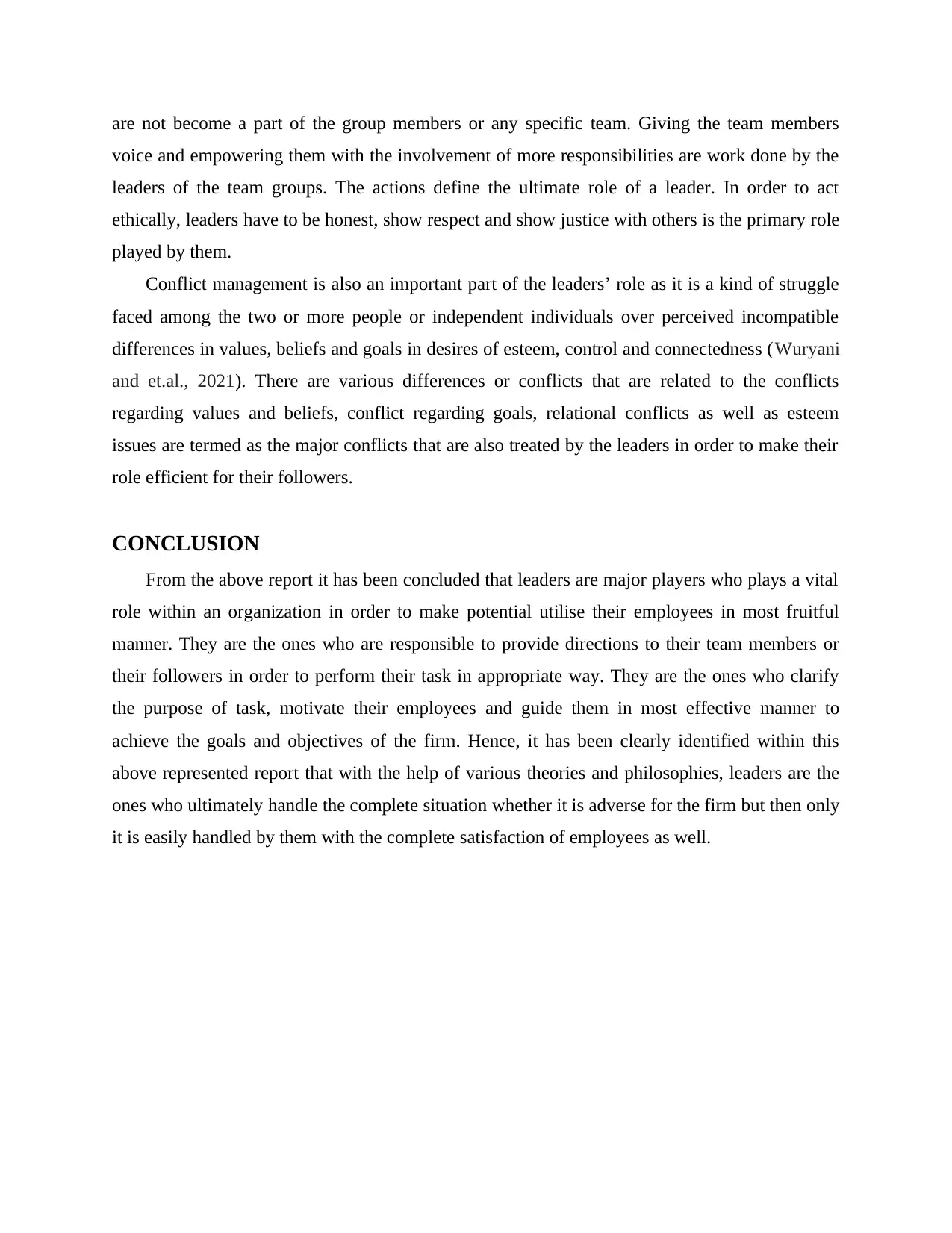
are not become a part of the group members or any specific team. Giving the team members
voice and empowering them with the involvement of more responsibilities are work done by the
leaders of the team groups. The actions define the ultimate role of a leader. In order to act
ethically, leaders have to be honest, show respect and show justice with others is the primary role
played by them.
Conflict management is also an important part of the leaders’ role as it is a kind of struggle
faced among the two or more people or independent individuals over perceived incompatible
differences in values, beliefs and goals in desires of esteem, control and connectedness (Wuryani
and et.al., 2021). There are various differences or conflicts that are related to the conflicts
regarding values and beliefs, conflict regarding goals, relational conflicts as well as esteem
issues are termed as the major conflicts that are also treated by the leaders in order to make their
role efficient for their followers.
CONCLUSION
From the above report it has been concluded that leaders are major players who plays a vital
role within an organization in order to make potential utilise their employees in most fruitful
manner. They are the ones who are responsible to provide directions to their team members or
their followers in order to perform their task in appropriate way. They are the ones who clarify
the purpose of task, motivate their employees and guide them in most effective manner to
achieve the goals and objectives of the firm. Hence, it has been clearly identified within this
above represented report that with the help of various theories and philosophies, leaders are the
ones who ultimately handle the complete situation whether it is adverse for the firm but then only
it is easily handled by them with the complete satisfaction of employees as well.
voice and empowering them with the involvement of more responsibilities are work done by the
leaders of the team groups. The actions define the ultimate role of a leader. In order to act
ethically, leaders have to be honest, show respect and show justice with others is the primary role
played by them.
Conflict management is also an important part of the leaders’ role as it is a kind of struggle
faced among the two or more people or independent individuals over perceived incompatible
differences in values, beliefs and goals in desires of esteem, control and connectedness (Wuryani
and et.al., 2021). There are various differences or conflicts that are related to the conflicts
regarding values and beliefs, conflict regarding goals, relational conflicts as well as esteem
issues are termed as the major conflicts that are also treated by the leaders in order to make their
role efficient for their followers.
CONCLUSION
From the above report it has been concluded that leaders are major players who plays a vital
role within an organization in order to make potential utilise their employees in most fruitful
manner. They are the ones who are responsible to provide directions to their team members or
their followers in order to perform their task in appropriate way. They are the ones who clarify
the purpose of task, motivate their employees and guide them in most effective manner to
achieve the goals and objectives of the firm. Hence, it has been clearly identified within this
above represented report that with the help of various theories and philosophies, leaders are the
ones who ultimately handle the complete situation whether it is adverse for the firm but then only
it is easily handled by them with the complete satisfaction of employees as well.
⊘ This is a preview!⊘
Do you want full access?
Subscribe today to unlock all pages.

Trusted by 1+ million students worldwide
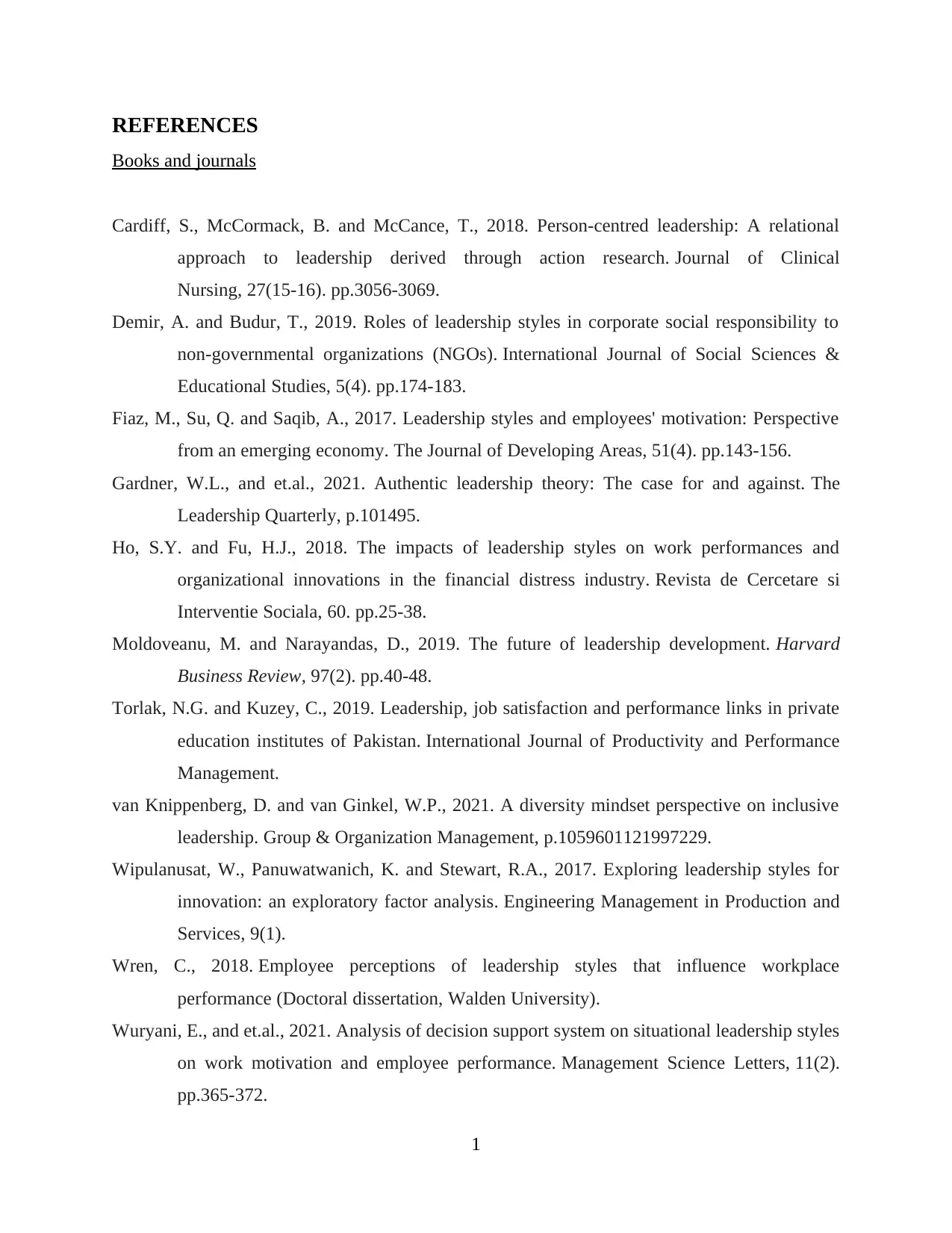
REFERENCES
Books and journals
Cardiff, S., McCormack, B. and McCance, T., 2018. Person‐centred leadership: A relational
approach to leadership derived through action research. Journal of Clinical
Nursing, 27(15-16). pp.3056-3069.
Demir, A. and Budur, T., 2019. Roles of leadership styles in corporate social responsibility to
non-governmental organizations (NGOs). International Journal of Social Sciences &
Educational Studies, 5(4). pp.174-183.
Fiaz, M., Su, Q. and Saqib, A., 2017. Leadership styles and employees' motivation: Perspective
from an emerging economy. The Journal of Developing Areas, 51(4). pp.143-156.
Gardner, W.L., and et.al., 2021. Authentic leadership theory: The case for and against. The
Leadership Quarterly, p.101495.
Ho, S.Y. and Fu, H.J., 2018. The impacts of leadership styles on work performances and
organizational innovations in the financial distress industry. Revista de Cercetare si
Interventie Sociala, 60. pp.25-38.
Moldoveanu, M. and Narayandas, D., 2019. The future of leadership development. Harvard
Business Review, 97(2). pp.40-48.
Torlak, N.G. and Kuzey, C., 2019. Leadership, job satisfaction and performance links in private
education institutes of Pakistan. International Journal of Productivity and Performance
Management.
van Knippenberg, D. and van Ginkel, W.P., 2021. A diversity mindset perspective on inclusive
leadership. Group & Organization Management, p.1059601121997229.
Wipulanusat, W., Panuwatwanich, K. and Stewart, R.A., 2017. Exploring leadership styles for
innovation: an exploratory factor analysis. Engineering Management in Production and
Services, 9(1).
Wren, C., 2018. Employee perceptions of leadership styles that influence workplace
performance (Doctoral dissertation, Walden University).
Wuryani, E., and et.al., 2021. Analysis of decision support system on situational leadership styles
on work motivation and employee performance. Management Science Letters, 11(2).
pp.365-372.
1
Books and journals
Cardiff, S., McCormack, B. and McCance, T., 2018. Person‐centred leadership: A relational
approach to leadership derived through action research. Journal of Clinical
Nursing, 27(15-16). pp.3056-3069.
Demir, A. and Budur, T., 2019. Roles of leadership styles in corporate social responsibility to
non-governmental organizations (NGOs). International Journal of Social Sciences &
Educational Studies, 5(4). pp.174-183.
Fiaz, M., Su, Q. and Saqib, A., 2017. Leadership styles and employees' motivation: Perspective
from an emerging economy. The Journal of Developing Areas, 51(4). pp.143-156.
Gardner, W.L., and et.al., 2021. Authentic leadership theory: The case for and against. The
Leadership Quarterly, p.101495.
Ho, S.Y. and Fu, H.J., 2018. The impacts of leadership styles on work performances and
organizational innovations in the financial distress industry. Revista de Cercetare si
Interventie Sociala, 60. pp.25-38.
Moldoveanu, M. and Narayandas, D., 2019. The future of leadership development. Harvard
Business Review, 97(2). pp.40-48.
Torlak, N.G. and Kuzey, C., 2019. Leadership, job satisfaction and performance links in private
education institutes of Pakistan. International Journal of Productivity and Performance
Management.
van Knippenberg, D. and van Ginkel, W.P., 2021. A diversity mindset perspective on inclusive
leadership. Group & Organization Management, p.1059601121997229.
Wipulanusat, W., Panuwatwanich, K. and Stewart, R.A., 2017. Exploring leadership styles for
innovation: an exploratory factor analysis. Engineering Management in Production and
Services, 9(1).
Wren, C., 2018. Employee perceptions of leadership styles that influence workplace
performance (Doctoral dissertation, Walden University).
Wuryani, E., and et.al., 2021. Analysis of decision support system on situational leadership styles
on work motivation and employee performance. Management Science Letters, 11(2).
pp.365-372.
1
1 out of 10
Related Documents
Your All-in-One AI-Powered Toolkit for Academic Success.
+13062052269
info@desklib.com
Available 24*7 on WhatsApp / Email
![[object Object]](/_next/static/media/star-bottom.7253800d.svg)
Unlock your academic potential
Copyright © 2020–2025 A2Z Services. All Rights Reserved. Developed and managed by ZUCOL.





